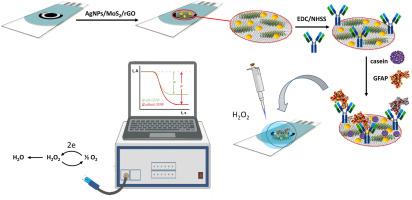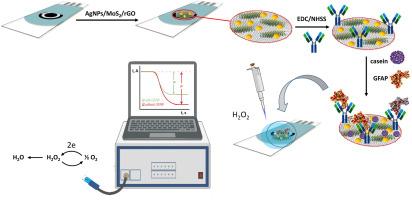Label-free electrochemical immunosensing of glial fibrillary acidic protein (GFAP) at synthesized rGO/MoS2/AgNPs nanocomposite. Application to the determination in human cerebrospinal fluid
Abstract
An electrochemical bioplatform involving screen-printed carbon electrodes modified with rGO/MoS2/AgNPs nanocomposites, the covalent immobilization of the specific capture antibody, and label-free detection has been developed for the determination of Glial Fibrillary Acidic Protein (GFAP). The resulting immunosensor profits the benefits of the rGO high conductivity, the pseudo-peroxidase activity of MoS2 and the electrocatalytic effect provided by AgNPs for improving the reduction current responses of hydrogen peroxide at the electrode surface. GFAP is a biomarker of central nervous system injuries has been proposed for the detection and monitoring of neurological diseases as epilepsy, encephalitis, or multiple sclerosis. For the first time, amperometric detection of the immunosensing event was performed by measuring the electrocatalytic response of hydrogen peroxide reduction at the modified electrode. Several techniques including scanning (SEM) and transmission (TEM) electron microscopies were used for the characterization of the synthesized composite whilst electrochemical impedance spectroscopy (EIS) using the redox probe Fe(CN)63−/4− was employed to evaluate the success of the steps implied in the fabrication of the immunosensor. After optimization of the involved experimental variables, a linear calibration plot for GFAP was constructed over the 0.6–100 ng mL−1 range, and a detection limit of 0.16 ng mL−1 was achieved. The developed immunosensor was successfully applied to the determination of GFAP in human cerebrospinal fluid (CSF) of patients diagnosed with encephalitis.



 求助内容:
求助内容: 应助结果提醒方式:
应助结果提醒方式:


